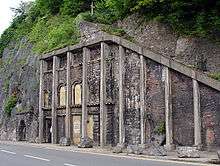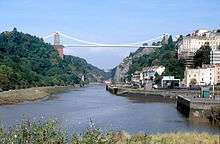Clifton Rocks Railway
| Clifton Rocks Railway | |
|---|---|
 Clifton Rocks Railway lower station | |
| Overview | |
| Type | Underground funicular |
| Locale | Hotwells, Bristol (grid reference ST565730) |
| Stations | 2 |
| Operation | |
| Opened | 11 March 1893 |
| Closed | 1 October 1934 |
| Technical | |
| Track gauge | 3 ft 2 in (965 mm) |

The Clifton Rocks Railway was an underground funicular railway in Bristol, England, linking Clifton at the top to Hotwells and Bristol Harbour at the bottom of the Avon Gorge in a tunnel cut through the limestone cliffs. The upper station is close to Brunel's famous Clifton Suspension Bridge and is located adjacent to the former Grand Spa Hotel (now the Avon Gorge Hotel). The lower station was opposite the paddle steamer landing ferries in Hotwells, Hotwells railway station of the Bristol Port Railway and Pier, a terminus of Bristol Tramways and the Rownham ferry enabling connections across the river Avon.
History
Construction of the railway was funded by the publisher George Newnes, also proprietor of the Lynton and Lynmouth Cliff Railway, and as at Lynton and Lynmouth the engineer was George Croydon Marks. It opened on 11 March 1893 and carried 6,220 passengers on the opening day.[1] However, it was never a great success; in 1912 it was sold to Bristol Tramways,[2] but it continued to struggle and closed on 1 October 1934.[3]
The railway had a length of 450 feet (137 m), overcoming a vertical distance of 200 feet (61 m) at a gradient of about 1 in 2.2 (45%). There were four cars in two connected pairs, essentially forming two parallel funicular railways, each running on 3 ft 2 in (965 mm) narrow gauge tracks. The system was operated by gravity, with water ballast being let into the cars at the top station and out at the bottom, and an oil- or gas-burning pump returning the water to the top of the system.[4]
During the Second World War blast walls were installed in the tunnel, which was used as offices by BOAC, as a relay station by the BBC (who also constructed an emergency studio there, though it was never put into use), and as an air-raid shelter. The BBC continued to use parts of the tunnel until 1960.[3][5]
Preservation
A voluntary group, which in 2008 became a charitable trust, aims to preserve and restore the railway. They hope to raise funds for a feasibility study into the complete restoration of the railway. The cost of complete restoration is estimated at around £15 million.[6]
See also
References
- ↑ Council, Design (1893), Engineering, Volume 55, Office for Advertisements and Publication, p. 332
- ↑ Klapper, Charles (1984), The Golden Age of Buses, Routledge, p. 186, ISBN 9780710202321
- 1 2 "Clifton Rocks Railway - History". Subterranea Britannica. Retrieved 3 June 2007.
- ↑ "Clifton Rocks Railway - FAQ". Clifton Rocks Railway special interest group. Retrieved 3 June 2007.
- ↑ "The Clifton Rocks Railway Tunnel". Old Radio Broadcast Equipment and Memories. Archived from the original on 26 September 2006. Retrieved 3 June 2007.
- ↑ "Clifton Rocks Railway - About Us". Clifton Rocks Railway special interest group. Retrieved 3 June 2007.
External links
| Wikimedia Commons has media related to Clifton Rocks Railway. |
- Clifton Rocks Railway website
- Clifton Rocks Railway refurbishment
- World War II BBC Studios, clip by BBC Points West
Coordinates: 51°27′14.4″N 2°37′31.7″W / 51.454000°N 2.625472°W